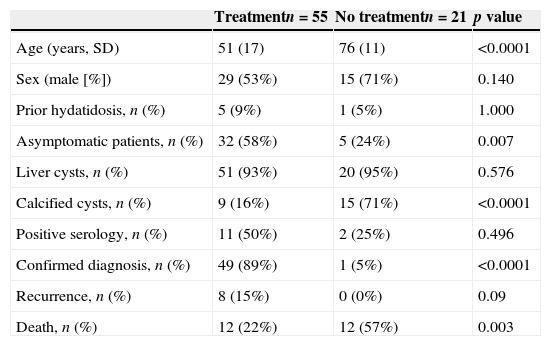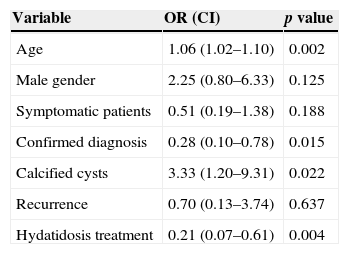To analyze the epidemiological and clinical characteristics and mortality of patients with cystic echinococcosis (CE) in northern Spain.
Patients and methodsA retrospective study of the medical records of patients diagnosed with CE and hospitalized from 1997 to 2011 in a University Hospital.
ResultsA total of 76 patients (44 men) were diagnosed with CE. The mean age was 57.8 years (SD: 19.1 years; range: 14.9–92.7). The yearly average incidence was 1.08 cases/100,000 inhabitants. The highest incidence was registered in patients aged 70–79 years (22.7% of all cases). Liver was the main organ involved (92.1%), followed by lung (6.6%) and peritoneum (1.3%). Fifty-five patients (72%) received treatment: 2 (3.6%) medical treatment with albendazole, 27 (49%) surgical treatment, 3 (5.4%) medical treatment combined with cyst drainage, and 23 (42%) combined medical and surgical treatment. Eight patients had a recurrence. Twenty-four (31.2%) patients died. No patient's death was attributed directly to hydatidosis, though mortality was significantly higher in the untreated vs. the treated patient group (57% vs. 22%, p=0.003).
ConclusionsHydatidosis treatment and diagnostic approaches remain heterogeneous. The liver continues being the main organ affected. Mortality was higher in patients who did not receive treatment. However, this result might have been influenced by other factors, mainly age.
Analizar las características epidemiológicas y clínicas y la mortalidad de los pacientes con equinococosis quística (EQ) en el norte de España.
Pacientes y métodos: Estudio retrospectivo de las historias clínicas de los pacientes diagnosticados de EQ, ingresados entre los años 1997 y 2011 en un Hospital Universitario.
ResultadosSe diagnosticaron de hidatidosis un total de 76 pacientes (44 varones). La media de edad fue de 57,8 años (DE: 19,1 años; rango: 14,9–92,7). El promedio de incidencia anual fue de 1,08 casos/100.000 habitantes. La incidencia más alta se registró entre los pacientes con una edad comprendida entre 70 y 79 años (22,7% de los casos). El hígado fue el principal órgano afectado (92,1%), seguido del pulmón (6,6%) y el peritoneo (1,3%). Recibieron tratamiento 55 pacientes (72%): 2 (3,6%) tratamiento médico (albendazol), 27 (49%) tratamiento quirúrgico, 3 (5,4%) tratamiento médico combinado con drenaje del quiste y 23 (42%) tratamiento médico y quirúrgico combinados. Presentaron recurrencias 8 pacientes, y fallecieron 24 (31,2%). Ninguno de los pacientes falleció por una causa atribuible a hidatidosis, aunque la mortalidad fue significativamente mayor en el grupo de los no tratados respecto al de los tratados (57% vs. 22%, p=0,003).
ConclusionesLa aproximación diagnóstica y terapéutica de la hidatidosis continúa siendo heterogénea. El hígado sigue siendo el principal órgano afectado. La mortalidad fue mayor en los pacientes que no recibieron tratamiento, si bien este resultado puede estar influido por otros factores, principalmente la edad.
Article
Diríjase desde aquí a la web de la >>>FESEMI<<< e inicie sesión mediante el formulario que se encuentra en la barra superior, pulsando sobre el candado.

Una vez autentificado, en la misma web de FESEMI, en el menú superior, elija la opción deseada.

>>>FESEMI<<<








